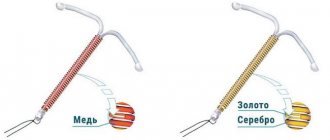The process of giving birth to a baby and the postpartum period require obstetricians to provide a certain correction to the woman’s condition with the help of medications. One of the drugs most used for these purposes is oxytocin after childbirth. This medicinal substance belongs to the hormones of the female body and is produced by the endocrine glands. The influence of oxytocin on the body of a woman in labor is quite strong; with its direct participation, labor is stimulated and lactation is enhanced. Why is he appointed?
How does oxytocin benefit a young mother?
As mentioned above, the hormone begins its journey in the body from the brain and, through the bloodstream, reaches its immediate target - the uterus and mammary glands. This drug has the greatest effect on the uterus; it enhances the contractility of the muscles of the uterine wall.
The basis of the female reproductive organ is smooth muscle, and it is the hormone that primarily influences its excitability. Uterine tone is one of the main factors influencing the process of childbirth.
It should be noted that the natural amount of oxytocin in the liquid fraction of blood remains the same throughout a woman’s life. Its percentage is not affected by menstruation and the early stages of pregnancy.
A sharp increase in the level of the drug in the blood is observed after 32 weeks. During this period, the percentage of the hormone increases 2-3 times, with an especially active increase in oxytocin at night. This anomaly is associated with the general hormonal background of a woman and its changes in the process of bearing a child.
After the onset of labor, the percentage of the hormone in the blood increases even more, which should stimulate the preparation of the uterine wall for the process of childbirth. A lack of oxytocin in a woman’s body during this important period can lead to the development of labor weakness and forced surgical obstetrics.
Oxytocin injections after childbirth are fully consistent with the concept of using the drug in obstetrics, as they stimulate contraction of the uterine walls and prevent the development of postpartum hemorrhage.
In addition to its effect on the smooth muscles of the uterus, oxytocin is used in medicine after childbirth to enhance lactation in a young mother. For this purpose, the drug has two useful functions:
- The hormone has a significant effect on the cells located near the areola, causing them to contract and mechanically enhancing the release of milk from the breast.
- The interaction of oxytocin with prolactin is also important. This substance is also a female sex hormone and is directly responsible for the production of mother's milk. Oxytocin enhances the effect of the latter, positively influencing the lactation process.
Many researchers have proven the effect of hormonal medicine on the thinnest strings of the human psyche. Large doses of oxytocin help relieve postpartum mental arousal in a woman and stimulate the rapid establishment of emotional connections between mother and baby. Oddly enough, experts emphasize the influence of this medicinal substance on the growth of a young woman’s confidence in medical workers, which is very important at all stages of the patient’s stay in the maternity hospital.
Watch this video about who is prescribed oxytocin:
Oxytocin: what is it and why is it needed?
Oxytocin is a hormone involved in regulating the process of childbirth. It is produced continuously by a woman’s body in various parts of the brain, and then transmitted into the blood. Vincent Du Vigneault, who received the Nobel Prize in Chemistry for this discovery, isolated and was able to artificially synthesize this hormone. During pregnancy, its concentration is low, but on the eve of childbirth it increases noticeably. The maximum level of oxytocin in the blood is observed at night, so many women give birth in the dark or at dawn.
During the first stage of the labor process, oxytocin acts on smooth muscles and promotes dilatation of the cervix. After labor is completed, the purpose of this hormone changes - it stimulates the production of prolactin and ensures active lactation. If labor is weak, injections are prescribed or oxytocin is administered through an IV to enhance it. This makes delivery easier. Oxytocin after childbirth improves uterine contractions.
Methods of using the drug in obstetrics
Oxytocin is used during childbirth for strict medical reasons. Its use is clearly regulated by orders of the Ministry of Health and local protocols.
Most often, this drug is necessary to enhance a woman’s labor, which may be due to medical indications. This may include:
- primary weakness of labor;
- long waterless period;
- presence of a clinic for mild to moderate preeclampsia.
Any conditions in obstetrics that threaten the life of the mother and child may be the reason for prescribing this drug. Experts note that the use of oxytocin can reduce the rate of cesarean sections. The only condition for using this medicine as a labor stimulant is the readiness of the birth canal and cervix for childbirth.
A direct indication is the presence of Rh conflict between mother and child. Prolongation of the time of birth in this case can lead to severe hemolytic pathologies in the fetus. The use of oxytocin in this case to stimulate labor is completely justified.
It is not recommended to use this medicine to accelerate normal labor, since gross interference with the physiological process can have a detrimental effect on the condition of the mother and child.
The drug is practically not intended for oral administration, since, being a natural hormone, oxytocin is completely decomposed in the stomach under the influence of an acidic environment. Most often, the medicine is administered to a woman’s body intravenously or intramuscularly.
The choice of method of using the drug depends on the required speed of obtaining the result: if injections of oxytocin after childbirth to contract the uterus can cause a delayed effect, then during childbirth the drug is usually injected into a vein to obtain an immediate result.
In this case, the effect of the drug on the mother’s body can be expected within 4 to 5 minutes: the uterus contracts, contractions intensify, and labor becomes more pronounced. The duration of action of the medicine with this method of administration does not exceed 3 hours.
It should be noted that this medicine is quickly destroyed, as a result of which its effect on the fetus is very small. Therefore, unlike many other drugs, oxytocin is widely used throughout the labor period.
Young mothers often ask obstetricians and gynecologists the question of why inject oxytocin after childbirth, since the main problems are already behind them. This female hormone will be useful for women even after the birth of the baby, but only in the first month.
Why is oxytocin administered during childbirth?
Oxytocin is constantly produced in a woman’s body in moderate quantities, so why introduce it artificially? This hormone stimulates uterine contractions during childbirth; in the third trimester of pregnancy, the sensitivity of the corresponding receptors increases, and preparation for labor begins.
The main effect of the hormone is directed on the muscles of the uterus and placenta. Nature provides a mechanism for removing oxytocin from the body and regulating its required concentration, which consists of the action of a special enzyme. Enzymes prevent contractions and pushing from becoming too active.
In cases where the balance of the hormone and enzyme is disturbed, medical intervention is required. Protracted, prolonged labor can be caused by insufficient dilatation of the cervix, weak functioning of the muscles of the uterus and abdomen. Incomplete dilatation of the cervix poses a risk of rupture in the mother and the possibility of distress in the fetus due to the fact that it moves through the birth canal for too long and experiences compression.
In the case of prolonged and difficult labor, the lack of natural oxytocin is compensated by the introduction of synthetic one. Women in labor are prescribed contraction injections. Further hormonal therapy helps the uterus recover. The organ needs to shrink to its natural size. Hormones then trigger the process of releasing breast milk. Drug therapy must be carried out after a cesarean section, when the normal recovery mechanisms of the woman’s body are disrupted.
Postpartum period - features of the course
The postpartum period lasts from 6 to 8 weeks, during which time the uterus returns to its previous size. Immediately after childbirth, the inside of the uterus is a continuous wound surface, covered with blood clots and remnants of the fetal membrane. When muscles contract, some of the lymphatic and blood vessels are compressed and dry out (obliterated). Some of the muscle cells that have grown during pregnancy die, while the rest decrease in size.
Within a day after natural birth, the fundus of the uterus drops 2 cm lower, and on days 9-10 it takes its usual place below the pubic line. The external uterine os, through which the remains of the placenta are sometimes removed manually, also contracts gradually. The next day it allows only one finger to pass through, and after three weeks it closes completely. A slit-like uterine pharynx is a sure sign of a woman who has given birth.
Oxytocin-Richter ampoules 5 IU, 1 ml, 5 pcs
* This product is not subject to exchange or return on the basis of Decree of the Government of the Russian Federation No. 55 of January 19, 1998. Prices in Pharmacy pharmacies may differ from the prices indicated on the website. When receiving prescription medications, you must present a prescription from your doctor.
1 ml of solution contains:
Active substance: oxytocin;
Excipients: glacial acetic acid; chlorobutanol hemihydrate; ethanol (96%); water for injections.
pharmachologic effect
Oxytocin is a uterotonic.
Increases the permeability of myometrial cell membranes for ions, increases its excitability and causes and enhances contractions of the smooth muscles of the uterus.
Stimulates lactation by promoting the contraction of myoepithelial cells in the alveoli of the mammary glands.
- Induction of labor during post-term pregnancy;
- excitation and stimulation of labor with premature rupture of amniotic fluid, with primary or secondary labor weakness;
- caesarean section (during the operation);
- management of labor in breech presentation, hypotension or atony of the uterus after childbirth, abortion (including termination of long-term pregnancy);
- lactostasis in the early postpartum period, painful premenstrual syndrome accompanied by edema, weight gain.
Hypersensitivity, clinically narrow pelvis, abnormal fetal position, complete placenta previa, threat of uterine rupture.
Use during pregnancy and breastfeeding
In the first trimester of pregnancy, oxytocin is used only for spontaneous or induced abortions.
Numerous data on the use of oxytocin, its chemical structure and pharmacological properties indicate that, if the instructions for use are followed, oxytocin does not affect the formation of fetal malformations.
Passes into breast milk in small quantities.
When using the drug to stop uterine bleeding, breastfeeding can be started only after completing the course of treatment with oxytocin.
Intramuscularly, intravenously (one-time injection, drip), into the wall or vaginal part of the cervix; intranasally.
During labor induction, intramuscularly - 1 IU at intervals of 30–60 minutes (depending on the reaction of the uterus); more appropriate - intravenous drip (10-30 drops per minute) - 1-3 IU in 300-500 ml of 5% glucose solution (under the control of the frequency of uterine contractions and fetal heartbeats) until the end of labor and after separation of the placenta.
To stimulate labor, intramuscularly - 0.5-1 IU with an interval of 30-60 minutes, or intravenously (as for induction of labor), depending on the obstetric situation (opening of the uterine pharynx, etc.). For breech birth - 2-5 IU. For hypotension and uterine atony - 5-10 IU, intravenously, in 10-20 ml of 40% glucose solution.
To stimulate lactation, intramuscularly or intranasally (using a pipette) - 0.5 IU 5 minutes before feeding; if necessary, the injection is repeated. For premenstrual syndrome - intranasally, from the 20th day of the cycle to the 1st day of menstruation.
Nausea, vomiting, arrhythmia, incl. in the fetus, bradycardia (maternal and fetal); hypertension and subarachnoid hemorrhage or hypotension and shock; water retention (before poisoning) - with prolonged intravenous administration; allergic reactions.
Before starting to use oxytocin, the expected beneficial effect of therapy should be compared with the possibility, although rare, of the development of hypertension and uterine tetany. Until the fetal head is inserted into the pelvic inlet, oxytocin cannot be used to induce labor.
Every patient receiving intravenous oxytocin should be hospitalized under the constant supervision of experienced professionals who are familiar with the drug and recognized as skilled in recognizing complications. Immediate, if necessary, assistance from a medical specialist must be provided.
During use of the drug, uterine contractions, cardiac activity of the mother and fetus, and blood pressure of the woman in labor should be constantly monitored to avoid complications.
If there are signs of uterine hyperactivity, oxytocin should be stopped immediately; As a result, uterine contractions caused by the drug usually subside soon. When used adequately, oxytocin causes uterine contractions similar to spontaneous labor.
Excessive stimulation of the uterus if the drug is used incorrectly is dangerous for both the mother and the fetus. Even with adequate use of the drug and appropriate monitoring, hypertensive uterine contractions occur with increased sensitivity of the uterus to oxytocin. The risk of developing afibrinogenemia and increased blood loss should be taken into account.
There are cases of death of a woman in labor as a result of hypersensitivity reactions, subarachnoid hemorrhage, uterine rupture and fetal death for various reasons associated with parenteral administration of the drug for induction of labor and stimulation in the first and second stages of labor.
As a result of the antidiuretic effect of oxytocin, overhydration may develop, especially when using a constant infusion of oxytocin and ingesting liquids.
The drug can be diluted in solutions of sodium lactate, sodium chlorate and glucose. The prepared solution should be used within the first 8 hours after preparation. Compatibility studies were carried out with 500 ml infusions.
Drug interactions
When oxytocin is administered 3-4 hours after the use of vasoconstrictors in conjunction with caudal anesthesia, severe arterial hypertension is possible. During anesthesia with cyclopropane and halothane, the cardiovascular effect of oxytocin may change with the unexpected development of arterial hypotension, sinus bradycardia and atrioventricular rhythm in a woman in labor during anesthesia.
Symptoms: depend mainly on the degree of hyperactivity of the uterus, regardless of the presence of hypersensitivity to the drug. Hyperstimulation with hypertonic and tetanic contractions or with a baseline tone of ≥15-20 mm aq. Art.
between two contractions leads to disordered labor, rupture of the body or cervix, vagina, bleeding in the postpartum period, uteroplacental insufficiency, fetal bradycardia, hypoxia, hypercapnia, compression, birth injuries or death.
Overhydration with convulsions as a result of the antidiuretic effect of oxytocin is a serious complication and develops with prolonged administration of large doses (40-50 ml/min).
Treatment of overhydration: withdrawal of oxytocin, restriction of fluid intake, use of diuretics to increase diuresis, intravenous administration of hypertonic saline, correction of electrolyte imbalances, control of seizures with appropriate doses of barbiturates, and provision of professional care for the patient in a coma.
At a temperature not exceeding 25 °C. (do not freeze).
Attention! The description of the drug on this page is a simplified and expanded version of the official instructions for use. Before purchasing or using the drug, consult your doctor and read the instructions approved by the manufacturer.
Information about the drug is provided for informational purposes only and should not be used as a guide to self-medication. Only a doctor can decide to prescribe the drug, as well as determine the dose and methods of its use.
The appearance of products and packaging may differ from those depicted on the Site.
Source: //farmiya.ru/oksitocin-rixter-amp-5me1ml-5-13566
Contraindications and side effects
Contraction injections for the uterus are contraindicated if:
- there are vascular and heart diseases;
- the uterine cervix is underdeveloped;
- hormonal drugs were used within 4-6 hours;
- an ectopic pregnancy was diagnosed;
- there are allergic reactions to the constituent components;
- gestosis;
- malposition;
- placental tissue is located in the lower uterine segment;
- there is a narrow pelvic bone;
- there are sutures, damage or ruptures on the uterus;
- the uterus may rupture.
In addition to the fact that injections help, they also have side effects, both in relation to the woman herself and the child.
A woman may experience:
- attack of nausea;
- cardiopalmus;
- increased blood pressure;
- cerebral hemorrhage;
- anaphylactic shock;
- circulatory disorders in the brain;
- bronchial spasm;
- uterine tone.
The child may have such deviations as:
- improper blood supply;
- lack of oxygen, which leads to suffocation;
- squeezing;
- death.
The dosage must be calculated with caution so as not to cause harm. It is strictly prohibited to use such drugs on your own at home.
Drugs to contract the uterus for the purpose of miscarriage
Thoughts about medical abortion come to the minds of those women who experience a delay in their periods, but have no plans to give birth to a child. Some who caused artificial menstruation due to a delay do not even consider that it was an abortion. In fact, taking drugs to contract the uterus and induce menstruation is an early abortion. Like surgical abortion, it requires consultation with a doctor. Why? Because if the drug is selected incorrectly, irreversible processes can occur in the body. However, if a woman still decides to terminate the pregnancy, then medical abortion is less dangerous for the woman’s health and leaves a chance to have children in the future. But these drugs still have a number of contraindications.
Contraction of the uterus after caesarean section
The uterus of a woman who has undergone surgery contracts much more slowly than after a natural birth.
First of all, this is due to a violation of the integrity of muscles, blood vessels and nerve endings. Also, the restoration of the uterus to its previous size is affected by the temporary restriction of the motor activity of women in labor - for the first day they lie under IVs, and subsequently, when walking, they experience pain and discomfort from a fresh suture.
Wearing a postoperative bandage after a cesarean section is mandatory!
Ways to accelerate uterine involution
After removing the placenta, a cold heating pad is placed on the mother’s stomach in the area of the uterus to speed up the onset of contractions. The woman feels the contractions as an unpleasant but tolerable aching pain in the lower abdomen. In some very rare cases, the pain during uterine contractions is so noticeable that it is necessary to administer intramuscular painkillers and antispasmodics.
In many maternity hospitals, women in labor are given injections of oxytocin, a hormone that accelerates the process of involution. Breastfeeding also has the same effect; when sucking, the concentration of oxytocin in a woman’s blood increases greatly and distinct twitching is felt in the muscles of the uterus.
Postpartum hygiene for women is also of great importance: washing, treating wounds, changing pads in a timely manner - all this will protect against infections and prevent possible complications. Doctors also recommend wearing a special postpartum bandage and restorative exercises.
A set of exercises to contract the uterus can be started the day after birth and continued for 10-12 weeks. It is important not to overdo it and exercise in a gentle manner.
How to protect yourself when using drugs for miscarriage?
If a woman performs a medical abortion at home without consulting a doctor, then this is already very dangerous. The first thing you need to do if you want to have a miscarriage in the early stages is to go to the gynecologist and get an ultrasound. To avoid harm to your health, follow several rules.
- Remember that while there is a large selection of drugs for miscarriage in pharmacies, they only stock emergency contraception drugs. If we are talking about a miscarriage lasting more than 3 days, then these drugs are available only in the hospital and are not sold without a prescription.
- Before taking pills to contract the uterus, a woman must undergo an ultrasound and standard tests. They usually test blood and a vaginal swab, as well as urine.
- There should be no suspicion of an ectopic pregnancy.
- After taking the pill, you should definitely stay in the hospital for two hours. If everything is fine, they will let you go home. If you need to take the pill again, there should be someone at home who will monitor the process and, if anything happens, call an ambulance.
- If the drug was prescribed to yourself and is not supervised by a specialist, then a piece of the fetus may remain inside the uterus. It will begin to decompose. This can lead to death.
- After a medical abortion, the patient is advised to take birth control pills to avoid another unplanned pregnancy.
So, from all of the above we can conclude:
- Medical abortion is the safest method for getting rid of an unwanted pregnancy.
- A woman can resort to emergency contraception on her own (immediately after sexual intercourse) or have an abortion for up to 42 days in a hospital using special medications.
- All these remedies have a number of contraindications that should not be neglected.
- Do not attempt self-medication abortion! Take care of your health by seeking advice from experienced specialists.
How to inject oxytocin
In most cases, it is recommended to use intravenous administration of the drug by infusion, maintaining a safe speed, monitoring the condition of the patient and the fetus. During the procedure, the responsible doctor must monitor the heartbeat of the fetus and the woman in labor, the intensity of uterine contractions, and blood pressure.
In some cases, it is recommended to take additional precautions:
- if a discrepancy between the size of the fetal head and the woman’s pelvis is established;
- with hypertension that developed during pregnancy;
- if there is a history of disturbances in the normal functioning of the cardiovascular system;
- during labor and late pregnancy;
- in the presence of scars in the lower segment of the uterus;
- if the fetus has died inside the uterus or the amniotic fluid is contaminated with meconium (there is a risk of developing an embolism).
If amniotic fluid has caused acute intoxication and hyponatremia, then the patient is contraindicated in administering large volumes of fluid.
When a long course of oxytocin is prescribed, the total volume of the solution for droppers is reduced and solutions are used that contain electrolytes rather than glucose as an auxiliary substance.
Oxytocin
When a woman is preparing to become a mother, and the expected date of birth is about to arrive, the hypothalamus produces the hormone oxytocin, which regulates labor and lactation.
It acts on the uterus, causing it to contract. The same effect is observed in the mammary gland. The myoepithelial cells surrounding the alveoli contract and, as it were, “squeeze” milk out of the ducts. But this is a natural, natural way. It happens that obstetricians-gynecologists note weak labor activity. The uterus contracts poorly and irregularly.
Figure 1 – Oxytocin helps the health of a woman and her child
Weakness of labor can lead to prolonged immobility of the fetus in the pelvic area of the woman in labor. And this can negatively affect the health of the woman and child. In this case, synthetic Oxytocin is used, which repeats the effect of the hormone of the same name.
That is, it stimulates labor and the production of prolactin. Also, Oxytocin helps retain fluid, maintaining its optimal amount; has a vasoconstrictor effect, preventing bleeding.
Oxytocin in ampoules (the name of the synthetic drug) is a prescription drug produced in the form of a solution for intramuscular (IM) and intravenous (IV) administration.
This is a transparent, colorless liquid without mechanical inclusions, the active substance in which is the synthetic hormone oxytocin (5 IU in 1 ampoule).
Auxiliary components are ethanol (96%), glacial acetic acid, chlorobutanol hemihydrate, water for injection.
Indications for use
Oxytocin is used to contract the uterus during and after childbirth strictly as directed and under the supervision of a physician. The instructions for use indicate the following cases when the drug can be prescribed:
- stimulation of labor in the first and second stages of labor with weakness (primary or secondary) labor contractions;
- induction of labor in the late or close period of pregnancy, in case of need for early birth due to intrauterine growth retardation, Rh conflict, gestosis, premature or early rupture of fetal membranes and rupture of amniotic fluid, intrauterine death of the fetus, post-term pregnancy (after 42 weeks );
- prevention and treatment of hypotonic bleeding after abortion, miscarriage, childbirth, cesarean section (after the birth of a child and separation of the placenta) (in order to accelerate postpartum involution of the uterus);
- additional therapy for failed or incomplete abortion;
- swelling, weight gain before menstruation;
- insufficient patency of the mammary gland ducts during lactation.
Oxytocin therapy includes induced labor. Cases of their occurrence:
- for late toxicosis;
- due to fetal death;
- if Rh conflict is detected;
- if the amniotic fluid has passed prematurely;
- when the pregnancy period is exceeded.
Contraindications
According to the instructions, Oxytocin is contraindicated in the following cases:
- narrow pelvis of the woman in labor (discrepancy between the sizes of the pelvis and the fetal head);
- presentation or prolapse of the umbilical cord;
- partial or complete placenta previa;
- oblique and transverse position of the fetus, interfering with spontaneous delivery;
- emergency situations requiring surgical intervention caused by the condition of the fetus or the woman in labor;
- excessive distension of the uterus;
- facial presentation of the fetus;
- fetal compression;
- uterine sepsis;
- fetal distress long before the onset of terminal pregnancy;
- severe gestosis (impaired kidney function, high blood pressure);
- hypertonicity of the uterus (appearing before childbirth);
- heart disease, arterial hypertension;
- renal dysfunction;
- breastfeeding period;
- multiple pregnancy;
- premature birth;
- previous extensive surgical intervention on the uterus and its cervix (including cesarean section);
- uterine passivity
- invasive stage of cervical carcinoma;
- hypersensitivity to oxytocin and other components of the drug.
Side effects
Like any drug, Oxytocin has unwanted reactions. If any occur during therapy, the drug is discontinued and accelerated diuresis is performed. These side effects may occur:
- Reproductive system: at high doses or hypersensitivity - uterine hypertonicity, tetany, spasm, uterine rupture, increased bleeding after childbirth (due to thrombocytopenia, hypoprothrombinemia or afibrinogenemia caused by oxytocin); sometimes – hemorrhages in the pelvic organs;
- Digestive system: nausea, vomiting, digestive tract dysfunction;
Figure 2 - Nausea may occur after taking Oxytocin
- Cardiovascular system (in the fetus and mother): at high doses - ventricular extrasystole, arrhythmia, severe hypertension (with the use of vasopressors), hypotension (when combined with the anesthetic cyclopropane), reflex tachycardia, shock; at a high rate of administration - subarachnoid (cerebral) bleeding, bradycardia;
- Water-electrolyte metabolism: with long-term (24 hours) slow intravenous administration, severe overhydration may occur (usually at a high infusion rate), occurring with convulsions and coma; rarely – death;
- Immune system: development of allergic reactions (including anaphylaxis); at a high rate of administration - bronchospasm; rarely – death.
Also, the use of Oxytocin can cause side effects in the fetus or newborn in the form of:
- neonatal (intrauterine) jaundice of newborns;
- low Apgar score within 5 minutes;
- at a high injection rate - hemorrhage in the retina of the eye;
- decrease in fibrinogen in fetal blood;
- with increased contractile activity of the uterus - residual changes in the central nervous system;
- arrhythmia (including tachycardia, sinus bradycardia, ventricular extrasystole);
- fetal death as a result of asphyxia.
Overdose
Figure 3 – Taking the drug strictly as prescribed by the doctor
It is very important to use Oxytocin as prescribed by your doctor and strictly as directed. This will help avoid negative consequences for both the woman and the child. Signs of a drug overdose include:
- uterine rupture;
- hypoxia;
- tetanus of the uterus;
- water intoxication;
- postpartum hemorrhage;
- hypercapnia;
- uteroplacental hypoperfusion;
- birth injuries and bradycardia in the fetus;
- convulsions.
Directions for use and dosage
Instructions for use of Oxytocin involve the use of a solution for intramuscular (IM) or intravenous (IV) administration. It is prohibited to simultaneously administer the solution intramuscularly and intravenously. The dosage is calculated by the attending physician, who takes into account the individual tolerance of the drug by the woman and the fetus.
The action of Oxytocin begins 1-5 minutes after its administration and lasts approximately 3 hours.
Oxytocin intramuscularly
If after childbirth the uterus contracts poorly, the woman is given injections depending on the individually calculated dose - from 2 to 10 IU.
Oxytocin intravenously
This method is used to enhance labor. The drug is administered in a hospital under the supervision of medical personnel.
It is worth noting that stimulation of the birth process cannot be carried out until the baby’s head appears.
Stimulation is carried out as follows:
- first, a saline solution that does not contain Oxytocin is injected;
- after 5 IU, Oxytocin is diluted in 1000 ml of non-hydrating liquid and the drug is administered at a rate of 2–16 drops per minute. To achieve the desired contractile activity of the uterine walls, the intensity is increased by 4–8 drops every 20–40 minutes;
- if the uterus has dilated to the required level (4-6 cm), its contractions correspond to natural labor, and no symptoms of fetal distress are observed, then the infusion rate is reduced in the reverse order.
During artificial childbirth, which takes place in late pregnancy, the rate of administration of the solution is 32–36 drops. Premature labor is an indication to increase the infusion rate to 80 drops per minute.
In this case, throughout the entire period of Oxytocin administration, it is necessary to monitor the child’s heartbeat, the tone of the uterus during contractions and at rest, as well as the frequency, strength and duration of its contractions.
Oxytocin for abortion
During an abortion, a woman is injected intravenously with a solution of 10 IU/ml of oxytocin and 500 ml of a 5% dextrose solution at a rate of 20–40 drops per minute.
Oxytocin for postpartum uterine bleeding:
Sometimes Oxytocin is indicated after termination of pregnancy or birth of a child. It eliminates uterine hypotonicity, preventing bleeding and endometritis.
- IV drip infusion (80–160 drops/min.): dissolve 10–40 IU of Oxytocin in 1000 ml of non-hydrating liquid; To prevent uterine atony, 20-40 mIU/min of Oxytocin is usually needed.
- IM administration: 5 IU/ml Oxytocin after separation of the placenta.
Increased milk separation. Oxytocin is used to prevent mastitis due to milk stagnation. And also, it stimulates the functioning of the mammary glands and normalizes the movement of milk through the ducts: IM - 2 IU.
Oxytocin to stimulate lactation in the postpartum period - IM or intranasally, 0.5 IU 5 minutes before feeding.
When giving birth in a breech presentation – 2-5 IU.
Premenstrual syndrome - intranasally, from the 20th day of the cycle to the 1st day of menstruation.
During a cesarean section (after removal of the placenta), the drug is injected into the uterine wall at a dose of 3-5 IU.
Careful regular monitoring during labor reduces the risk of postpartum bleeding.
Improper use of the drug is dangerous for both mother and baby.
Analogs
Figure 4 – Analogues of the drug Oxytocin
There are analogues of Oxytocin on the pharmaceutical market. All of them are aimed at stimulating the smooth muscles of the uterus during childbirth. Thus, the following substitute drugs can be distinguished:
- Syntocinon. The active substance is a nonapeptide identical to the hormone oxytocin. Stimulates the muscles of the uterus and is used during childbirth, when the number of specific receptors for the hormone is increased in the myometrium;
- Oxytocin-Vial is a Russian-made drug that increases tone and increases myometrial contractions;
- Oxytocin-Grindeks is a Latvian synonym for Oxytocin;
- Oxytocin-MEZ is a drug that has virtually no vasoconstrictor and antidiuretic effect; the solution does not cause contraction of the intestinal or bladder muscles;
- Oxytocin-Richter – provides a myotonic effect, which occurs 3–7 minutes after administration and lasts 2–3 hours;
- Oxytocin-Ferein - stimulates uterine contractions, labor, eliminating hypolactation.
1 – Who is prescribed Oxytocin?
Source: //uteka.ru/articles/lekarstvennye-preparaty/oksitocin/
Oxytocin after childbirth: is it necessary or not?
The natural hormone is extremely necessary for a woman in labor in the early postpartum period. Its effect on the female body simultaneously solves several problems.
Effect on the uterus
Often in practical obstetrics situations arise when the postpartum uterus does not shrink to its natural size. Various factors may contribute to this. But an overly stretched uterus threatens a woman with the possibility of developing inflammation or bleeding in the early postpartum period.
To combat such complications, oxytocin is used after childbirth. To prevent relaxation of the uterine walls, the drug is usually prescribed in a dosage of 5 IU intramuscularly up to 4-5 times a day for 3-4 days. Longer use of the medicine is not effective, since the uterus becomes unresponsive to the effects of oxytocin.
If uterine bleeding has already developed in the early postpartum period, then the dose of the drug and the method of its administration change. After this complication has resolved, you can return to the initial dosage.
We recommend reading the article about inflammation of the uterus after childbirth. From it you will learn about the causes of postpartum inflammation of the organ, symptoms and signs of a problem in a young mother, methods of diagnosis and therapy.
Hormonal lactation stimulator
During natural breastfeeding, the role of oxytocin and prolactin is extremely important. The hormone helps increase milk production in the mammary glands, stimulates the milk ducts and affects the tubules of the areola.
It should be noted that in a woman’s body there is a special mechanism responsible for the increased release of oxytocin. When a baby sucks at the breast, the nerve endings of the nipple of the mammary gland are irritated, an impulse travels along the nerve fibers to the brain, and oxytocin is released into the vascular bed.
Among other things, the hormonal drug has a certain anesthetic effect, which reduces pain for the mother when feeding the child.
If a woman notices a decrease in the amount of oxytocin in the body, the doctor may prescribe the drug to the patient by injection. The release of milk from the nipples when the baby cries, the appearance of drops on the nipple of the second breast during feeding and other little things will help determine the occurrence of a decrease in the percentage of the hormone in the blood of a young mother.
It should be noted that intramuscular administration of the drug into the body of a nursing woman can provoke pathological reactions in the baby, therefore this method of treatment can only be used up to 14 days after birth.
What drugs are allowed to be used?
You can induce a miscarriage by taking medications during pregnancy up to 6 weeks. The use of tablets must be strictly according to the instructions. If everything is done correctly, then no unexpected effects or surprises will occur. This is usually a safe and painless method of ending a pregnancy. After taking the drugs, the woman begins her period and the pregnancy is terminated.
There are six effective drugs that cause miscarriage by contracting the uterus.
- Postinor. This drug has established itself as a method of emergency contraception. Usually they resort to this drug if unprotected sexual intercourse has occurred and pregnancy is not planned. The intake should be carried out according to the following scheme: one tablet immediately after sexual intercourse (not immediately, but most importantly, not later than 74 hours). The next tablet is taken 12 hours after the previous one. Experts' opinions on this drug are divided. It is generally accepted that termination of pregnancy in this way occurs only in 85% of cases. Postinor will not give a 100% result. Price from 265 rub.
- Escapelle. The drug is quite similar in its properties to Postinor. This is also a method of emergency contraception. It causes uterine contractions and subsequent emergency menstruation. There is only one tablet in the package. The intake should occur immediately after sexual intercourse. Since these tablets contain a large amount of active substance, an overdose can cause serious problems with hormonal levels. Price from 435 rub.
- Pencrofton. This product cannot be purchased at a pharmacy. It is issued under the supervision of a specialist. These pills are perfect for women who have not yet given birth, but do not intend to do so yet. This drug causes miscarriage with an almost one hundred percent guarantee. After it, infertility will not develop. Dosage: Take 3 tablets immediately and stay in the hospital for two hours. Two days later, do an ultrasound. The drug has no analogues.
- Mifegin. This drug blocks the production of the pregnancy hormone progesterone. After taking the pills, the uterus softens, changes its size, and the cervix opens. As a result, the fertilized egg is released. This drug is close to 100% effective. Side effects from it are minimal. The appointment is carried out under the supervision of a doctor. The package contains 3 tablets, which should be taken immediately. The woman must remain in the hospital for 2 hours after the appointment. After 1.5-2 days an ultrasound should be performed, and after two weeks one more time. If the pregnancy remains, then cleansing is performed. Price from 2930 rub.
- Mytholian. The drug is designed to terminate pregnancy for up to 49 days. He is capable of causing a miscarriage only in the early stages. After an ultrasound has been performed and the pregnancy is confirmed, the woman takes three Mifolian tablets. After 1.5-2 days, you should take 2 more tablets of Misoprostol. This will cause contractions in the uterus and a miscarriage will occur. These pills should be taken strictly in a hospital setting. Price from 1320 rub.
- Mifeprex. This remedy terminates pregnancy up to 42 days. There is no point in taking it after that. The effectiveness of the medicine has been proven and has almost no side effects. After administration, bleeding is observed for three days. If they continue after this period, you should go to the gynecologist. There are three tablets in the package. You should drink them together and go for an ultrasound two days later to make sure that a miscarriage has occurred. Price in pharmacies from 1400 rubles. per package.
Side effects and overdose
Side effects of the synthetic hormone oxytocin include:
- nausea, vomiting;
- heart rhythm disturbances;
- allergic reactions;
- hypertension;
- antidiuretic effect;
- placental abruption, uterine rupture as a result of excessive intensity of labor;
- decreased amount of fibrinogen in the fetus;
- subarachnoid hemorrhage;
- neonatal complications, including neonatal jaundice.
An overdose of the drug provokes excessively intense contractions of the uterus, which lead to rupture of the walls of the organ. Newborns often experience postpartum injuries of various types. If an excess dose of the hormone is detected, the doctor immediately stops administering it and prescribes diuretics.
General contraindications
An important thing a woman should remember: if she decides to use drugs to contract the uterus to cause a miscarriage, then first of all, let her make sure that the delay is definitely caused by pregnancy. After all, if a woman just thought she was pregnant, then the bleeding that began with the help of these drugs could be pathological.
In addition, there are a number of absolute contraindications for taking pills for the purpose of miscarriage. Do not under any circumstances resort to this type of abortion if you have at least one of them.
- Suspicion of ectopic pregnancy;
- the fact of pregnancy while wearing an intrauterine device;
- inflammation of the pelvic organs in the acute stage;
- exacerbation of stomach diseases: ulcers, gastritis, pancreatitis;
- lung diseases, including asthma;
- taking corticosteroids;
- liver and kidney failure;
- personal intolerance to the drug;
- blood diseases (hemophilia, anemia);
- use of anticoagulants;
- heart valve prosthesis;
- arterial hypertension.
There are a number of contraindications that are relative. Taking medications to contract the uterus should be taken with extreme caution.
- Women over 35 years of age who smoke 10 cigarettes or more per day;
- Myoma;
- Lactation.
Oxytocin and childbirth
The process of bringing a child into the world requires a lot of physical and moral strength from a woman. The drug "Oxytocin" will always help the fair sex at all stages of labor and in the early postpartum period.
In addition to the beneficial properties of this medicine listed above, the natural hormone has a beneficial effect on a woman’s mental state, reduces the likelihood of developing postpartum psychosis, and promotes the rapid adaptation of a young mother to a new role.
Oxytocin will help the postpartum mother calmly experience the first contact with her baby and critically perceive all the recommendations and wishes of the medical staff.
The price of the drug in the pharmacy chain makes it accessible to the widest segments of the population. In terms of price and quality ratio, this hormonal medicine is perhaps the most popular at the time of childbirth and in the early postpartum stage. Oxytocin is currently one of the most needed drugs in obstetrics.
Drugs
Immediately after completing any procedure to terminate a pregnancy, doctors place an ice pack on the woman’s lower abdomen. This leads to vasoconstriction, suppression of bleeding and contraction of the uterus. For a healthy woman, cooling the uterine area after a miscarriage is sufficient for its contraction. And also when interrupting a short term, doctors do without the use of drugs.
In later stages of gestation, bladder catheterization is performed to contract the uterus after abortion. Since the uterus and bladder are innervated from the same nerve plexus, overfilling of the latter leads to relaxation of the myometrium. After an abortion, doctors remove urine through a pre-installed catheter.
Since miscarriage or abortion are unnatural for the body in a state of pregnancy, many systems do not respond to the emptying of the uterus as a signal of the need for its contraction. After normal childbirth, which was preceded by a cascade of various chemical reactions in the body, the pituitary gland produces oxytocin and, under its influence, the myometrium contracts. Therefore, specialists often have to “help” the uterus contract after a miscarriage or abortion with drugs.
In obstetrics, three groups of drugs that contract the uterus are used.
- Ergot alkaloids (Ergometrine, Methylergometrine).
- Oxytocin drugs.
- Prostaglandins.
To contract the uterus after a miscarriage or abortion, prostaglandin drugs are most often used. This group of drugs is the most effective among the drugs used in obstetrics that contract the myometrium.
The effect of prostaglandins is due to the fact that the drugs are able to contract the smooth muscles of the uterine body under any circumstances, whereas after natural childbirth, obstetricians more often use oxytocin. The uterus, ready for normal labor, is equipped with a large number of receptors for oxytocin, so if it is hypotensive in the first day after birth, these drugs are used to reduce it. Until the third trimester, the myometrium does not have such a number of receptors, so oxytocin will not perform its functions.
In addition to these drugs that contract the uterus after a miscarriage, a drug called Analgin-quinine is occasionally used, which is not included in the official register of uterotonics, but its use is justified by the necessary mechanism of action on the myometrium.











